Exploring the Four Carat Teardrop Diamond Ring
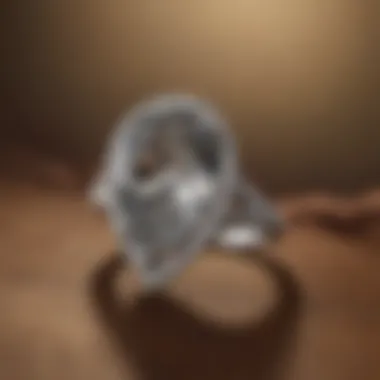
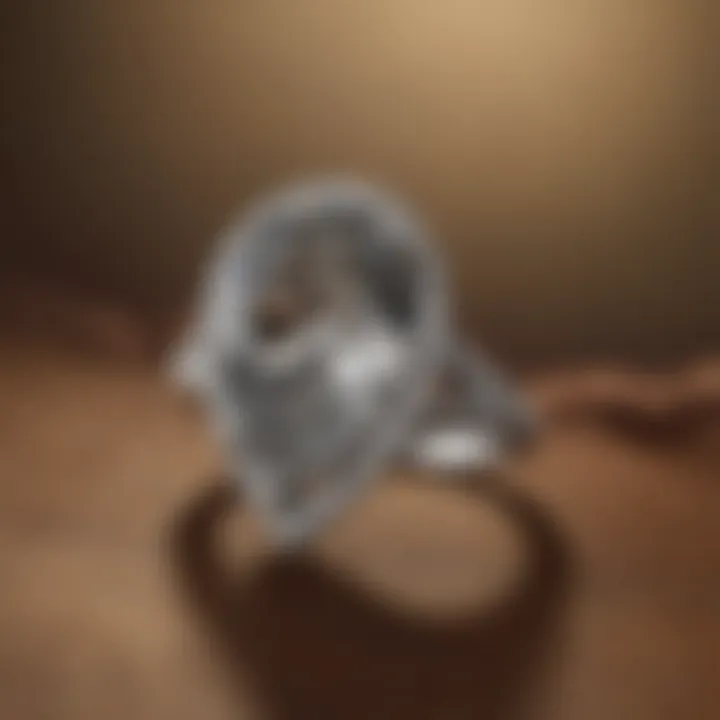
Intro
In the intricate world of gemstones, few radiate the captivating allure that a four carat teardrop diamond ring brings to the table. This ring, with its elegant design and remarkable brilliance, has become a pinnacle of beauty sought after by those who appreciate fine jewelry. Understanding what makes these rings special entails delving into various facets, from their unique aesthetic appeal to the craftsmanship behind their creation.
A four carat teardrop diamond ring is not just a piece of jewelry; it is a statement. The teardrop shape, often seen as a symbol of emotion and elegance, draws the eye and invites admiration. When one encounters a diamond of this size, its radiance captures attention and sparks curiosity. But what exactly is it about these rings that make them so alluring? This article aims to answer that question, exploring the complexities of the gemstone and the significance it holds in both personal and cultural contexts.
Ultimately, whether you are a seasoned collector or someone considering purchasing a ring for a special occasion, the knowledge you gain here will guide your choices, helping you appreciate the finer details of the four carat teardrop diamond ring.
Prelude to Four Carat Teardrop Diamond Rings
When discussing gemstones, few pieces radiate as much charm and elegance as the four carat teardrop diamond ring. It’s not just a piece of jewelry; it’s an emblem of beauty, sophistication, and personal taste. This ring can captivate a casual observer just as easily as it can mesmerize a seasoned gem collector. In this section, we will dive deep into the significance, the exquisite details, and the various facets that make the four carat teardrop diamond ring so alluring.
Definition and Characteristics
So, what is a four carat teardrop diamond ring? At its core, it features a diamond cut into an elongated shape reminiscent of a raindrop. This unique shape allows the stone to dance with light, showcasing a radiant brilliance that many other cuts simply can't compete with.
The weight of four carats is a defining feature, suggesting not only size but also the substantial presence it brings to the wearer's hand. The setting often enhances the teardrop’s beauty; many opt for delicate platinum or white gold mounts to really let the diamond shine. Look closer, and you may also find intricate detailing around the band, adding an artistic touch that speaks to the craftsmanship involved.
Key Characteristics to Note:
- Shape: The teardrop shape adds elegance and versatility, easily transitioning from casual to formal settings.
- Carat Weight: Four carats is substantial, and its weight usually denotes more than just size; it can influence the perceived value.
- Setting: The choice of metal—platinum, gold, or other—can enhance or diminish the ring's overall appeal.
Cultural Significance of Diamond Rings
Historically, diamonds—particularly in the form of rings—carry a weight of meaning that transcends mere aesthetic allure. They symbolize purity, strength, and eternity, often marking significant life events such as engagements and weddings. Across cultures, the diamond ring has remained a prominent token of love and commitment. In certain traditions, gifting a diamond is believed to bring happiness and prosperity to the couple.
Moreover, the teardrop cut specifically has cultural connotations as well. Its shape reflects emotion and grace, commonly associated with romance and deep connection. It's fascinating to see how something as simple as a cut can carry such depth.
Both modern and traditional societies view diamond rings, especially those shaped into a teardrop, as status symbols. Wearing such a ring signals not only personal taste but also an appreciation for craft and luxury, intertwining the wearer's identity with the beauty of the gemstone itself.
"A diamond is forever, but its beauty also lies in the moments it represents."
Understanding Diamond Carat Weight
When it comes to diamond jewelry, particularly the alluring four carat teardrop diamond ring, understanding carat weight is pivotal. Carat is not just a number; it embodies the size, rarity, and ultimately the value of a diamond. For gemstone enthusiasts and jewelry designers, grasping the significance of carat weight can transform the way they perceive and choose diamonds.
The concept of carat can be thought of as the currency of diamonds in a way. With each increase in carat weight, the diamond becomes a more coveted gem. A four carat diamond is not only rare but it also commands attention, making it a profound choice for personal adornment or investment. Understanding carat weight gives insight into how to gauge a diamond's brilliance and desirability, impacting all who appreciate fine jewelry.
What Does Carat Mean?
The term "carat” has historical roots that trace back to the use of carob seeds as a measure for weighing gemstones. Today, one carat is equivalent to 200 milligrams. But carat weight alone doesn’t tell the whole story; there are nuances to consider.
Diamonds can vary in size despite having the same carat weight. This is largely due to the cut of the diamond, which can influence how it reflects light. Thus, a well-cut diamond can appear larger than it actually is.
Understanding the nuances of carat weight allows potential buyers to make informed decisions. For instance, two diamonds can carry the same carat weight but differ significantly in cut quality and brilliance, which might make one ring more desirable than the other.
Impact of Carat on Value
The value of diamonds is intricately tied to their carat weight. As mentioned earlier, the rarity of higher carat weights translates to higher prices.
A four carat teardrop diamond ring will often be priced significantly higher than a one carat version, as larger diamonds are less common. However, the value doesn't only depend on the size; it is also affected by the other three Cs: Cut, Clarity, and Color.
- Cut: A high-quality cut can enhance the diamond’s brilliance and fire, making it more visually appealing.
- Clarity: Diamonds with fewer inclusions are more sought after, elevating the price per carat.
- Color: While some prefer colorless diamonds, others might go for those with a slight hue, which can also influence market value.
A deeper understanding of carat weight helps one appreciate the intricate balance between size, quality, and price, ensuring that buyers feel confident in their selection.
Teardrop Cut: An Overview
The teardrop cut, often heralded as a design marvel in the world of fine jewelry, really captures attention in a way that few shapes can. Its graceful contours blend elegance with a hint of drama, making it a standout choice for anyone looking to make a statement. This section delves into the significance of the teardrop cut, particularly focusing on how it differs from other cuts, while also celebrating its unique aesthetic appeal.
Teardrop versus Other Cuts
When comparing the teardrop cut to others like round, princess, or oval, a distinct individuality emerges. The teardrop diamonds are often described as both romantic and sophisticated, resembling the drop of water or a gentle tear.
- Shape and Length: The elongated silhouette of the teardrop cut offers a slender appearance that can elongate the fingers, presenting a flattering profile.
- Versatility: It can be set in various styles—solitaires, halo settings, or even as part of intricate designs—allowing it to fit in a range of personal aesthetics.
- Light Reflection: While round cuts are known for their brilliance, a well-cut teardrop can produce a unique play of light, often creating a soft, luminous glow that other cuts may lack.
- Setting Potential: The tapered end of the teardrop lends itself beautifully to various settings, making it adaptable to both classic and modern styles. In contrast, more common cuts may not provide the same level of versatility for design elements.
In essence, the teardrop cut offers something different, a mix of grace and charm that’s hard to ignore.
The Aesthetic Appeal of Teardrop Shapes
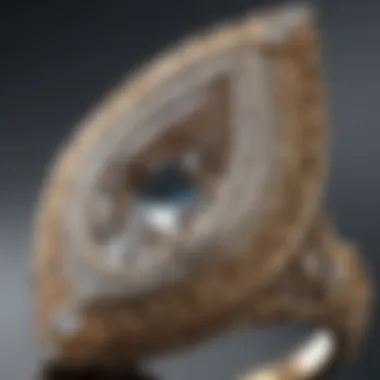
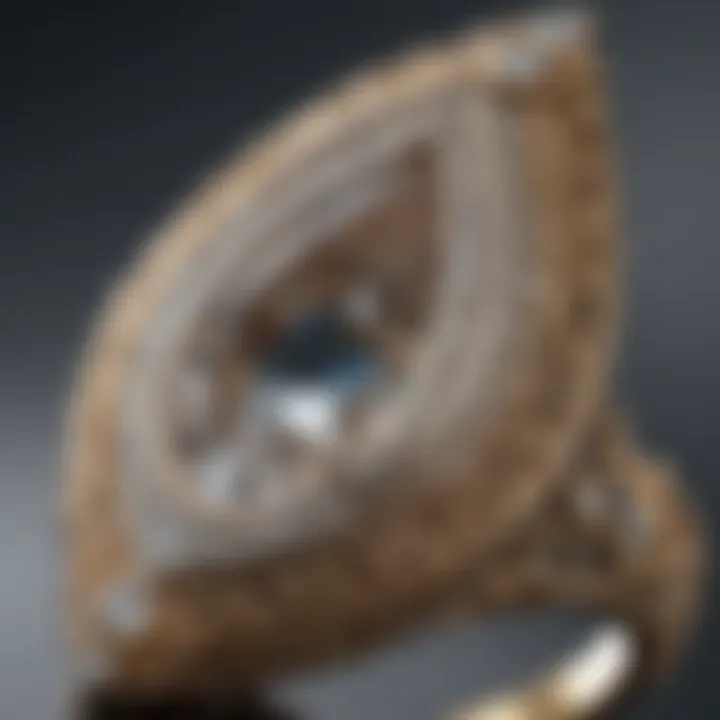
The aesthetic appeal of the teardrop shape is multifaceted. First and foremost, its graceful form evokes a deep emotional resonance, often associated with love and remembrance. The visual flow from wider end to point captures the eye and draws attention without overwhelming the wearer—an ideal balance.
- Romantic Symbolism: The teardrop shape is often linked to feelings of love and beauty, enhancing its desirability as an engagement ring option or as a special gift for significant occasions.
- Artistic Expression: Jewelers frequently harness the fluidity of this cut to create pieces that mimic natural forms, like leaves or petals, evoking nature's beauty and intricacy.
- Layering Potential: The elongated shape allows it to layer well with other rings. Pairing a teardrop with bands or stacking it with other styles can create a visually striking ensemble.
- Color Play: In colored diamonds or gemstone variations, the teardrop cut can emphasize hues beautifully, allowing shades to flow seamlessly from one area to another, a feature that round or square cuts might struggle to highlight as nicely.
The marriage of elegance and emotion embodied in the teardrop cut makes it not just a diamond but a story waiting to unfold.
"A teardrop isn’t merely a shape; it��’s a feeling, a moment captured in time, waiting to resonate with the beholder's heart."
Figure of Merit: The Quality of Diamonds
Understanding the quality of diamonds is crucial when considering a four carat teardrop diamond ring. The term "Figure of Merit" encapsulates the various attributes that contribute to a diamond's allure and perceived value. In this context, the quality of a diamond isn't merely about its size; it incorporates a broader spectrum of characteristics, fundamentally affecting both its beauty and its cost.
Evaluating the quality effectively sets the stage for what one can expect from a ring's appearance and longevity. The intricate characteristics of a diamond are distilled into the well-known Four Cs: Cut, Clarity, Color, and Carat. Each of these elements plays its role in determining the diamond’s overall value and desirability.
The Four Cs of Diamonds
Cut
The cut of a diamond is arguably the most significant factor influencing its sparkle and engagement. It refers to how well a diamond has been shaped and faceted. A well-cut diamond reflects light beautifully, using its geometry to maximize brilliance, whereas a poorly cut diamond may appear dull, irrespective of its carat weight. The most well-regarded cuts, like the brilliant cut, take full advantage of the diamond's inherent properties to create that sought-after shine.
A key characteristic of cut is its ability to enhance the visual appeal of the diamond. For a four carat teardrop shaped diamond ring, a flawless cut ensures that the shape’s elegance is highlighted, making it a popular choice among connoisseurs. However, it's important to note that achieving this level of perfection can demand higher prices and expertise in craftsmanship.
Clarity
Clarity refers to how clear or flawless a diamond is. This quality is assessed based on the presence of inclusions or blemishes visible under 10x magnification. A higher clarity grade—such as Flawless or Internally Flawless—often translates to a pricier piece.
In teardrop diamond rings, clarity is crucial, as the elongated shape can accentuate minor imperfections if they exist. A diamond with excellent clarity can engage the eye without distractions, maintaining a sense of purity. For collectors and those who value perfection, clarity holds high importance, ensuring long-lasting admiration for the ring.
Color
Color assesses the presence of any hues in what is otherwise a colorless diamond. Color grading ranges from D (colorless) to Z (light yellow or brown). The ideal choice for a four carat teardrop diamond ring often leans towards the D-F range, ensuring the diamond exhibits a pristine, clean look.
While the hue may seem subtle, it can shift the ring's overall presentation significantly. A diamond with less color allows more light to reflect through, enhancing its beauty. Conversely, a colored diamond can offer a unique character, appealing to those with a more adventurous style.
Carat
Carat measures the weight of the diamond, and it's a factor that directly affects its price. While carat alone doesn't define beauty, a four carat diamond certainly commands attention. Diamonds with larger carat weight, especially those in unique cuts such as teardrop, tend to stand out in any setting.
However, carat weight should be carefully considered alongside the other Cs. A larger diamond that's poorly cut may not catch the eye as effectively as a smaller, well-cut stone. Therefore, a balance between carat and the other qualities is crucial when selecting a teardrop diamond ring.
Evaluating Ring Quality
Choosing a ring isn't just about numbers; it's about appreciating the craftsmanship that goes into creating a piece of art. Evaluating the quality of a four carat teardrop diamond ring involves examining the interplay of the Four Cs meticulously. A deeper understanding of these factors provides a richer perspective on what makes a diamond not just a ring, but a gem of significance.
"Can you imagine the allure of a well-crafted ring that simply speaks to the heart, bridging the gap between mere jewelry and a sentimental piece? It's more than adornment; it’s a story that continues to unfold."
This means that when one considers purchasing a diamond ring, it should be a well-informed decision, recognizing that beauty comes from multiple facets—each contributing to the diamond's overall integrity and value.
Craftsmanship Excellence in Jewelry Making
When it comes to selecting a four carat teardrop diamond ring, the craftsmanship behind the ring matters immensely. This encompasses various elements, from the type of metals used in the mounting to the intricate artisan techniques employed in the setting of the diamond. Excellence in craftsmanship not only boosts the visual appeal of the jewelry but also affects its durability and longevity. For gemstone enthusiasts and collectors, understanding these aspects ensures that they make informed decisions when purchasing a piece that symbolizes both love and commitment.
Materials Used in Mounting
Types of Metal
The choice of metal serves as the foundation for any diamond ring, shaping its overall aesthetic while offering practical benefits. Among today’s selections, platinum, white gold, yellow gold, and rose gold stand out for their unique characteristics.
For example, platinum is highly regarded for its strength and durability—qualities essential for safeguarding a precious diamond. It's a popular choice for the teardrop setting as it not only enhances the diamond's brilliance but is also hypoallergenic, making it suitable for many wearers. However, its high cost can be a drawback for some.
Alternatively, white gold offers a shiny finish, giving the impression of platinum at a more affordable price point. The rhodium plating typically used can wear off over time, necessitating periodic replating to maintain its shine. Yet, for many, this maintenance is a small price to pay for the stylish look it gives.
- Yellow gold, with its warm hues, evokes a classic charm and is often favored for vintage-inspired pieces. This metal provides a contrasting backdrop that can showcase the brilliance of a teardrop diamond, enhancing its allure.
- Rose gold, noted for its romantic tint, has gained popularity among modern jewelers. Its unique warmth draws attention and can reflect a wearer’s personal style. However, it may not suit everyone's taste.
In summary, the choice of metal should resonate with the wearer’s personal preferences while considering the diamond's visual impact.
Alternative Gemstones
Though diamonds reign supreme when it comes to engagement rings, alternative gemstones offer unique narratives and broaden the creative possibilities of jewelry design. Stones such as sapphires, moissanite, and morganite enter the scene as popular choices, each with its characteristics contributing to the entire ring's ambiance.
For instance, sapphires are known for their striking color and exceptional hardness, making them both beautiful and highly durable. They are often used in bespoke designs, appealing to those wanting something distinct yet symbolic. Their blue hue can complement a teardrop diamond, creating a stunning contrast that signifies elegance and uniqueness.
Moissanite, often lauded as a diamond substitute, boasts exceptional brilliance at a fraction of the price. This gemstone is renowned for its fire and scintillation, capturing the eye much like a diamond, and can serve those wanting a visually striking alternative without the hefty price tag.
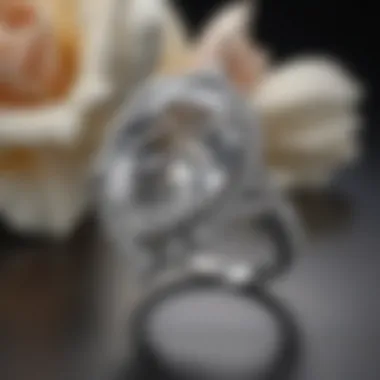
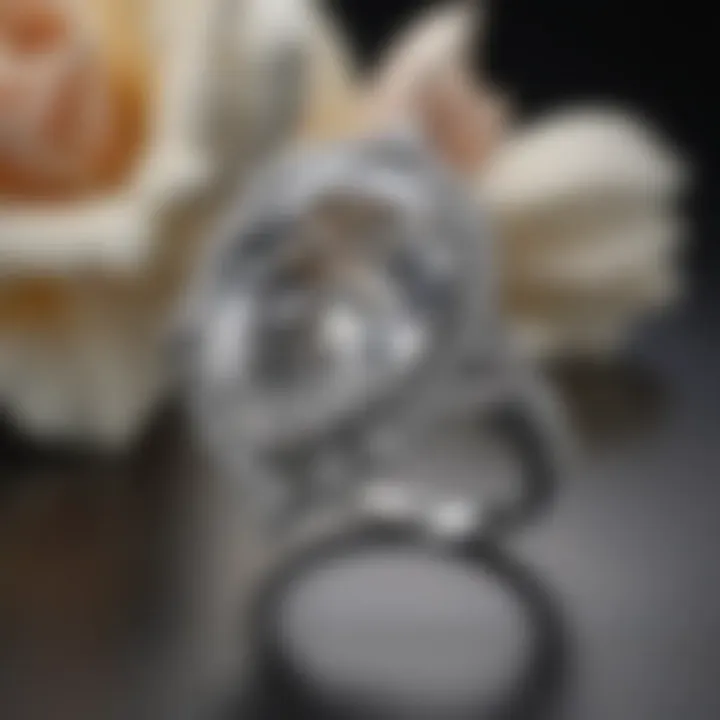
- Morganite, a lesser-known option, provides a soft peachy pink hue that appeals to many modern couples. This gemstone imbues a romantic essence, making it a charming selection for those who desire something less traditional.
- However, it’s worth noting that compared to diamonds, alternative gemstones may have varying durability and could require more care to prevent damage.
Artisan Techniques for Teardrop Settings
The artistry involved in creating a teardrop diamond ring forms an integral part of its charm. Artisan jewelers employ various techniques to ensure that the diamond is beautifully showcased. Intricate settings often elevate the appearance of a teardrop diamond, highlighting its unique silhouette. Craftsmanship excellence in this domain translates into secure settings that not only accentuate the diamond but ensure its safety during everyday wear.
The skillfully executed prong setting enhances the stone's visibility while allowing maximum light to penetrate the diamond, unleashing its radiant fire. On the other hand, bezel settings, wrapping the diamond snugly in metal, offer a modern twist while providing added protection for the edges of the stone. This is particularly essential for precious gems like a teardrop diamond that can sometimes be more delicate due to their shape.
Artisan techniques also include various finishes, such as matte or polished surfaces, which lend a distinctive flair to the piece. These choices reflect the wearer’s personality while giving the ring a handcrafted feel, adding to its allure and significance in jewelry aesthetics.
"A well-crafted piece of jewelry is more than mere ornamentation; it's a silent testament to the artistry and skill behind it, creating lasting impressions that transcend time."
Choosing the Right Four Carat Teardrop Diamond Ring
Choosing the right four carat teardrop diamond ring is no small feat. It’s not just about picking a shiny piece of jewelry; it’s an art that encompasses personal style, budget considerations, and so much more. This ring is more than just a sparkler. It often symbolizes significant moments in life, such as engagements or anniversaries. Having so many angles to consider, let's navigate through the essentials of selecting your perfect ring.
Consider Your Personal Style
When it comes to jewelry, personal style is paramount. Each individual’s taste can swing from the minimalist aesthetic to bold and extravagant selections. A four carat teardrop diamond ring can resonate in various design forms, so it helps to sit down and ponder your style before diving into the selection.
- Are you drawn to classic elegance? A simple band with a prominent teardrop might be just what you need.
- Or do you lean toward edginess? Consider unique settings like halo configurations that incorporate smaller diamonds around the teardrop, making it stand out further.
- Think about your lifestyle. If you lead an active life, perhaps a ring designed close to the finger may be more suitable to avoid snagging.
Your choice should align with your own flair. It’s also helpful to keep in mind the clothes in your wardrobe. A ring should not only complement your style but should also see the light of day often, adding to your overall look.
Understanding Your Budget
Let’s face it, for most of us, budgets are real, and diamonds can get pricey. Understanding what you can spend is crucial when deciding on a four carat teardrop diamond ring. A little planning goes a long way in making your dream ring a reality without breaking the bank.
- Prioritize your needs. Consider if you want to invest more in the diamond quality or the setting.
- Research prices. Understand what price ranges you can expect and watch out for sales or discounts. It doesn’t hurt to aim at getting the best bang for your buck.
- Be open to alternatives. Not every teardrop ring has to feature a diamond; alternative gemstones can offer stunning visuals and substantial savings. For example, a moissanite can mimic a diamond's sparkle at a fraction of the cost.
Ultimately, being realistic about what you can afford not only makes the shopping experience smoother but also ensures satisfaction and happiness once you make that big purchase.
Selecting the right four carat teardrop diamond ring is a journey combining elegance with practicality. It’s not solely about the shine but about what fits best into your life and style.
Market Trends for Diamond Jewelry
The world of diamond jewelry, particularly teardrop diamond rings, is influenced heavily by changing market trends. Understanding these trends can provide insights not only into fashion and aesthetics but also into investment opportunities. As preferences evolve, so do the styles and societal perceptions surrounding diamond jewelry.
Contemporary Preferences and Styles
In recent years, there has been a notable shift in consumer preferences regarding diamond jewelry. Buyers are increasingly gravitating toward rings that offer both uniqueness and emotional resonance. Here are some contemporary trends shaping the market today:
- Sustainable Sourcing: More customers are showing interest in ethically sourced diamonds. They prefer rings that not only catch the eye but also align with their values on sustainability and responsible sourcing.
- Personalized Designs: Customization is gaining traction. People want rings that tell their story, reflecting their personal taste or significant life events. This has led to a rise in bespoke designs, making the teardrop diamond ring a popular choice.
- Alternative Diamonds: Stones like lab-created diamonds and colored diamonds are becoming more mainstream. This has opened up a wider range of choices for consumers, allowing them to explore options beyond the traditional clear diamonds.
Recognizing these preferences can help both buyers and sellers make informed decisions in a fluctuating market.
Investment Potential of Teardrop Diamonds
Investing in teardrop diamonds—especially larger ones like the four carat variety—has its perks. They are not simply beautiful pieces of jewelry; they bear significant investment potential as well. Here are key factors to consider:
- Rarity: Larger diamonds, especially those with flawless clarity and beautiful cut, are becoming increasingly rare. As demand grows and supply diminishes, their value can appreciate over time.
- Cultural Symbolism: Teardrop diamonds often symbolize emotion and elegance, making them eternally appealing. They tend to remain in demand, not just as personal pieces but also in the collectors' market, enhancing their investment worth.
- Artistic Craftsmanship: With the intricate designs often accompanying teardrop settings, these rings can also reference significant artistic craftsmanship. Jewelry pieces of high quality tend to hold their value better than mass-produced items.
Moreover, owning a four carat teardrop can be an elevating experience for any collector or jewelry enthusiast, blending beauty with financial prudence.
"Diamonds are not just a girl's best friend; they are also a savvy investment choice."
In light of the ongoing market dynamics, understanding these trends becomes crucial for anyone looking to appreciate, collect, or invest in diamond jewelry. Familiarity with current styles and the investment potential can lead to informed decisions, ensuring that your diamond ring not only sparks joy but serves as a lasting asset.
Caring for Your Teardrop Diamond Ring
Caring for a four carat teardrop diamond ring is not just about preserving its stunning appearance; it's also about maintaining a significant investment. The unique shape and quality of these diamonds require considerate stewardship to keep them sparkling as they day they were first set. Ignoring proper care can lead to dullness, scratches, or even loss of stones, diminishing their brilliance and emotional value.
Cleaning Tips for Longevity
Regular cleaning is essential for any diamond ring, especially one as exquisite as the teardrop design. Over time, dirt, oil, and grime can build up, clouding the diamond’s natural luster. Here are some practical tips to keep it shining:
- Gentle Soaking: Mix warm water with a few drops of mild dish soap. Soak your ring for about 20–30 minutes. This loosens any stuck debris.
- Soft Brushing: Using a soft-bristled toothbrush, gently brush the diamond and the setting. This helps to remove any persistent dirt without scratching.
- Rinsing and Drying: After brushing, rinse your ring under warm water (taking care to avoid the drain!). Pat it dry with a soft, lint-free cloth.
- Avoid Products: Stay away from strong chemicals and abrasive cleaners. They might hamper the finish or damage the metal settings.
By implementing these cleaning rituals every couple of weeks, you can enhance the ring’s longevity and keep its sparkle intact.
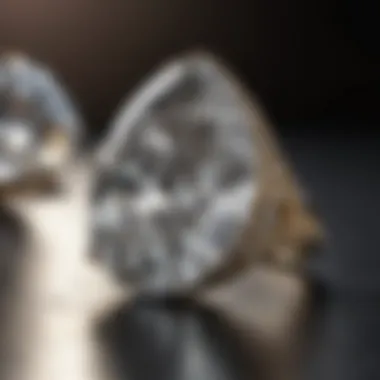
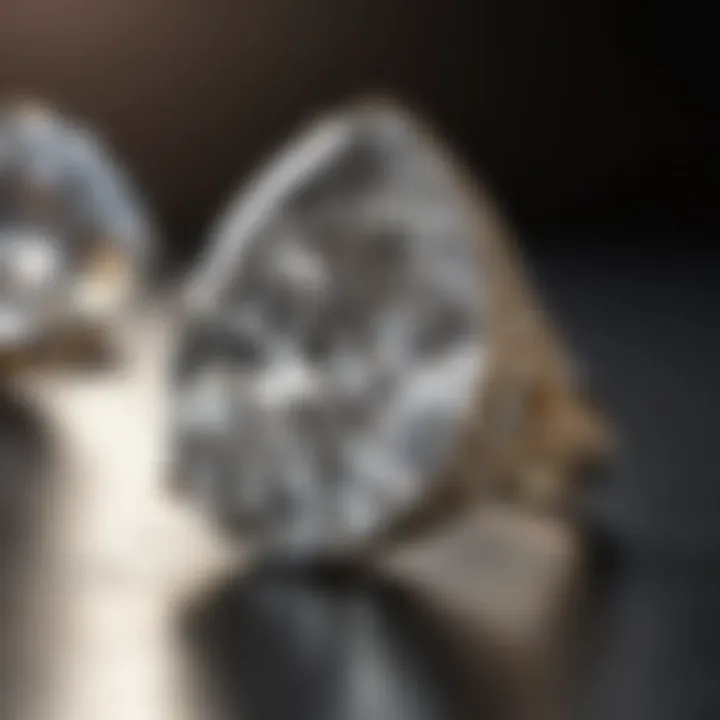
Regular Maintenance and Professional Servicing
In addition to cleaning, regular maintenance is critical in preserving the structural integrity of your teardrop diamond ring. Sometimes, a DIY approach isn’t enough. Professional servicing can catch potential issues before they become problems. Here’s what you should keep in mind:
- Checking for Loose Stones: A jeweler can verify that the diamond is securely set. Loose settings can lead to the diamond falling out—a heart-stopping situation!
- Polishing and Rhodium Plating: If your ring has white gold or platinum settings, consider professional polishing or rhodium plating. These processes can restore shine and protect the metal from scratches and tarnishing.
- Annual Inspections: It’s advisable to take your ring to a professional for a complete checkup at least once a year. This includes examining the setting, cleaning, and making any needed adjustments or repairs.
Taking these steps ensures that your teardrop diamond ring remains a captivating symbol of love and commitment for years to come. As the saying goes, a stitch in time saves nine; in this case, a little effort in maintenance can save a lot of heartache later.
Symbolism and Meaning of Diamonds
Diamonds have fascinated humanity for centuries, not only because of their beauty but also due to their rich cultural significance and what they represent in the context of human relationships. The weight of meaning behind a diamond, particularly a four carat teardrop diamond ring, extends well beyond its physical properties. It symbolizes love, commitment, and enduring beauty, intertwining itself into the narratives of countless couples around the globe. In this section, we’ll peel back the layers to understand the emotional weight and cultural implications of these stunning stones.
Emotional Significance in Relationships
In the realm of romance, diamonds hold a special place. Often viewed as the ultimate symbol of love and fidelity, they are commonly exchanged during special moments such as engagements or anniversaries. When one gives a four carat teardrop diamond ring, it’s not simply a piece of jewelry but a profound gesture that signifies a deep emotional connection.
- Love Everlasting: Traditionally, diamonds are often associated with eternity. Their hardness represents an unbreakable bond, standing the test of time in the most challenging circumstances. Every glance at this precious gemstone serves as a reminder of a cherished relationship.
- Milestone Markers: A diamond ring can symbolize significant emotional milestones. For many, gifting a diamond ring marks a pivotal moment in their love story—be it an engagement, a milestone birthday, or an anniversary.
- Personal Narratives: Each diamond tells a unique story. How one acquires the diamond, the emotions tied to its purchase, and the occasions it celebrates all add layers of personal significance. This narrative enhances its value beyond mere monetary worth.
As you admire a teardrop diamond ring, understand that these moments and memories are imbued within the stone, each facet reflecting a piece of your own journey.
Diamonds Across Cultures
The diamond’s allure isn’t just confined to Western societies. Across the globe, various cultures have their own interpretations and traditions associated with diamonds:
- Middle Eastern Traditions: In ancient Persia, diamonds were believed to be tears of the gods, symbolizing purity. To this day, they are often incorporated into bridal jewelry as a blessing for the future.
- Indian Culture: Diamonds have been treasured in India for thousands of years. They symbolize wealth and status and are often embedded in royal jewelry. The cut and clarity of the diamond can reflect the wearer’s social standing and taste.
- Western Engagement Culture: The tradition of diamond engagement rings, highly popularized by De Beers in the 20th century, reflects a cultural paradigm where diamonds are seen as not just a symbol of engagement, but an expectation within many romantic relationships.
Through these lenses, diamonds emerge as a universal symbol of love and commitment, yet their meanings can vary widely from one culture to another, weaving an intricate tapestry of human emotion and tradition.
“A diamond is forever, representing unwavering commitment and the promise of a bright future together.”
Customizing Your Diamond Ring
When it comes to diamond rings, particularly the striking four carat teardrop variety, the idea of customization stands out as a key element for many buyers. Personalization can transform a beautiful piece of jewelry into something that resonates on a deeper level, making it uniquely yours. The allure of a customized ring isn’t just in the diamond itself, but in the story that it tells—an expression of individual personality, taste, and sentiment.
Customizing a diamond ring allows individuals to select every detail—from the type of metal for the band to the specific design elements that will set the ring apart. This level of involvement not only enhances the aesthetic value but also ensures that the piece captures the essence of the wearer or the occasion it celebrates.
Some important considerations during the customization process may include:
- Personal Style: What styles or designs resonate most with you?
- Budget Considerations: How can your design choices align with what you’ve set aside for this purchase?
- Lifestyle Compatibility: Will your chosen design fit well with everyday life?
By delving into these considerations, buyers can create a diamond ring that not only sparkles but also reflects a part of themselves.
Bespoke Design Options
Bespoke design options provide a canvas for creativity and personal expression. When looking to customize a four carat teardrop diamond ring, one has the freedom to explore a variety of bespoke design choices. The beauty of a teardrop shape lies in its elegant silhouette, which can be accentuated with myriad design options:
- Setting Styles: Choose from various settings such as prong, bezel, or halo. Each offers a distinct look and feel that can greatly enhance the overall appearance of the diamond.
- Metal Choices: Popular choices include white gold, yellow gold, and rose gold. The metal selected can dramatically alter the ring's visual appeal.
- Engravings: Adding a personal touch, such as an engraving on the band, can make the ring even more meaningful—be it names, dates, or small quotes that hold significance.
- Gemstone Accents: Incorporating smaller accent stones can add color or contrast, making your teardrop diamond the centerpiece of a thriving ensemble. Options could include sapphires, emeralds, or even smaller diamonds to complement the main stone.
This extensive range of bespoke options not only allows for individual artistry but also creates a lasting legacy, one that can be passed down through generations.
Working with Jewelers for Custom Pieces
Collaborating with a skilled jeweler is crucial when embarking on the journey of customizing your diamond ring. An experienced jeweler can guide you through the available options and help refine your ideas into a cohesive design. Here are some key points to consider when engaging with a jeweler for custom pieces:
- Research Jewelers: Find jewelers who specialize in custom work. Look for reviews or testimonials from past clients to gauge their level of experience and craftsmanship.
- Consultations: Schedule meetings to discuss your vision. A good jeweler will take the time to understand your style preferences, budget, and any specific requests you may have.
- Visual Aids: Some jewelers provide computer-generated images or sketches to give you a better idea of how the finished piece will look. Visual aids can make it easier to adjust designs before committing to the final product.
- Quality Assurance: Always inquire about the materials and techniques used in the creation of the ring. A trustworthy jeweler will ensure high-quality workmanship and can provide certifications for the diamonds used.
Partnering with a jeweler can turn an abstract idea into a tangible masterpiece, ensuring that the customized four carat teardrop diamond ring is not just a piece of jewelry but a cherished work of art.
Epilogue: The Timeless Appeal of Teardrop Diamond Rings
As we've traversed the multifaceted world of four carat teardrop diamond rings, it becomes glaringly evident that their allure reaches far beyond mere aesthetics. These rings embody not just a stone, but a narrative wrapped in emotions, cherished moments, and cultural significance. The fusion of art and craftsmanship shines through, resulting in pieces that are both a personal statement and a universal symbol of love.
Lasting Value and Significance
In the realm of fine jewelry, few things can parallel the lasting value attributed to teardrop diamond rings. A four carat diamond holds inherent worth, rooted in factors like the quality of the stone and the meticulous artistry that goes into crafting the setting. For many, these rings are not mere accessories. They represent milestones: engagements, anniversaries, or significant achievements in life. The teardrop shape, evocative of both tears of joy and the flow of time, enhances this emotional connection.
The significance of a teardrop diamond ring extends into the realm of status, often acting as a hallmark of success or deep-seated affection. However, unlike other valuable assets, the emotional resonance tied to these rings lends them a transcendental quality. As they change hands, from one generation to the next, they carry stories, memories, and legacies, retaining their worth far beyond what might be indicated by the market alone.
Future of Diamond Jewelry
Looking ahead, the future of diamond jewelry, particularly four carat teardrop models, appears ripe with possibility. With ongoing advancements in technology, the creation of lab-grown diamonds is reshaping the market landscape. Although some purists remain devoted to mined stones, lab-grown options offer unparalleled clarity and ethical considerations, appealing to a newer generation that values sustainability alongside luxury.
Additionally, digital platforms are becoming increasingly pivotal in the diamond buying journey. Prospective buyers can now explore a plethora of designs, compare prices, and even view gemstones in 3D—a leap from traditional methods. This tech-savvy approach not only broadens accessibility but also modernizes how buyers perceive and appreciate diamond jewelry.
As tastes evolve, the allure of teardrop diamond rings adapts. Expect a rise in innovative designs intertwined with technology, giving birth to unique personalization options that resonate with individuality. In a world that craves authenticity, such offerings will likely affirm the teardrop diamond's position in both timeless elegance and contemporary fashion.
"Diamonds are forever, but the stories they carry evolve with each wear—personal and cultural narratives interwoven through time."



